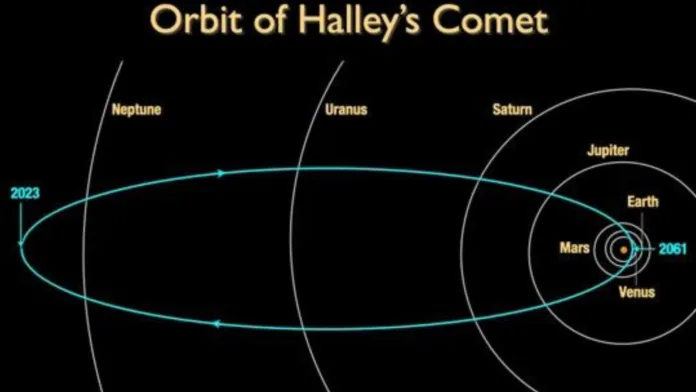Halleys Comet 2023:Prepare yourself for an adventure across space and time! The famous Halley’s Comet will arrive at Aphelion, the furthest point in its 75-year orbit around the Sun, on December 9, 2023. This is a momentous occasion in its heavenly journey, providing an opportunity to consider its past, present, and future.
Table of Contents
An Extraordinary Voyage Into the Outer Solar System:
Halley’s Comet has been traveling silently through the icy depths of the outer solar system since its last sighting in 1986. It’s been a long and difficult journey, spanning far beyond what can be seen with even the strongest telescopes.
Halleys Comet 2023 Reaching the Farthest Point, Aphelion:
At a distance of roughly 35.14 AU (3.3 billion miles) from the Sun, Halley’s Comet will be at its furthest point on December 9, 2023. It is invisible to the unaided eye and even the majority of telescopes due to its great distance, which puts it well outside of Neptune’s orbit.
Also Read: The Hubble Space Telescope Issue: Exploring Gyro Fault the Potential for a Private Rescue Mission
Beyond Perception: A Far-Off and Dim Comet
Halleys Comet 2023 shines at a faint magnitude of +35 at its aphelion, rendering it unobservable without specialized equipment. Its slow speed of 0.91 km/s makes taking pictures of it more difficult.

No Pictures from the Space Telescope: Why NASA Won’t Look
Although the James Webb and Hubble Space Telescopes can both observe far-off objects, NASA does not intend to take pictures of Halley’s Comet when it is closest to its aphelion. This is because the scientific benefits are outweighed by the comet’s faintness and the technical difficulties in pointing telescopes at such a far-off object.
A Historical Legacy: Indications and Wonders:
For centuries, humanity has been enthralled with Halley’s Comet, which has left its imprint on mythology and history. Its sporadic appearances have been read as portents, a source of both wonder and terror. Sir Edmond Halley identified it as a periodic comet for the first time in 1696, although Chinese observations from 467 BC had documented sightings of it.
Also Read: NASA’s Laser Breakthrough: Paving the Way for Faster Deep Space Communications
A Look Into the Future: The Appearance of 2061
When Halley’s Comet returns to perihelion, its closest point to the Sun, in 2061, the next chapter in its history will begin. This will be an amazing event that gives skywatchers a chance to see this celestial traveler up close and personal.
Relics from the past: The Meteor Shower of Eta Aquariids:
The Eta Aquariid meteor shower is a way for us to witness Halley’s Comet’s remnants even though we are unable to see the comet itself at this time. This yearly event takes place when Earth passes through comet tail debris in late April or early May. At this time, light streaks in the night sky provide insight into the comet’s past for observers.
Conclusion:
The vastness and wonder of the universe are brought to mind by Halley’s Comet. It encourages us to look beyond our planet and consider the mysteries that lie beyond as it continues its journey across the cosmos. We can continue to study its legacy and be in awe of this celestial traveler while we wait for its return in 2061.
Disclaimer:
AI was used to conduct research and help write parts of the article. We primarily use the Gemini model developed by Google AI. While AI-assisted in creating this content, it was reviewed and edited by a human editor to ensure accuracy, clarity, and adherence to Google's webmaster guidelines.


